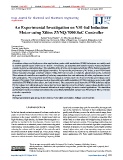Page 108 - 2024-Vol20-Issue2
P. 108
Received: 1 July 2023 | Revised: 2 September 2023 | Accepted: 28 September 2023
DOI: 10.37917/ijeee.20.2.9 Vol. 20 | Issue 2 | December 2024
Open Access
Iraqi Journal for Electrical and Electronic Engineering
Original Article
An Experimental Investigation on VSI-fed Induction
Motor using Xilinx ZYNQ-7000 SoC Controller
Santosh Yadav Maddu*1, Dr. Nitin Ramesh Bhasme2
1Department of Electrical Engineering, Government College of Engineering, Aurangabad, Maharashtra, India
2Department of Electrical Engineering, Government College of Engineering, Yavatmal, Maharashtra, India
Correspondance
*Santosh Yadav Maddu
Research Scholar, Department of Electrical Engineering,
Government College of Engineering, Chhatrapati Sambhajinagar,
Maharashtra, India - 431005
Email: princesantoshyadav@gmail.com
Abstract
In medium voltage and high-power drive applications, pulse width modulation (PWM) techniques are widely used
to achieve effective speed control of AC motors. In real-time, an industrial drive system requires reduced hardware
complexity and low computation time. The reliability of the AC drive can be improved with the FPGA (field programmable
gate array) hardware equipped with digital controllers. To improve the performance of AC drives, a new FPGA-based
Wavect real-time prototype controller (Xilinx ZYNQ-7000 SoC) is used to verify the effectiveness of the controller.
These advanced controllers are capable of reducing computation time and enhancing the drive performance in real-
time applications. The comparative performance analysis is carried out for the most commonly used voltage source
inverter (VSI)-based PWM techniques such as sinusoidal pulse width modulation (SPWM) and space vector pulse width
modulation (SVPWM) for three-phase, two-level inverters. The comparative study shows the SVPWM technique utilizes
DC bus voltage more effectively and produces less harmonic distortion in terms of higher output voltage, flexible control
of output frequency, and reduced harmonic distortion at output voltage for motor control applications. The simulation
and hardware results are verified and validated by using MATLAB/Simulink software and FPGA-based Wavect real-time
controller respectively.
Keywords
Field programmable gate array, Motor control, Pulse width modulation, Voltage source inverter.
I. INTRODUCTION signal and a constant duty cycle for controlling the output volt-
age of the inverter [3]. Because of their outstanding output
In the last decade, extensive research has been conducted on quality and efficiency across the whole control range, three-
power electronics-based electrical drives due to their vast ap- phase voltage-source inverters are commonly used in motor
plications in the power industry [1]. Major factors such as drive systems [4]. It contains a DC link with a capacitive filter
high efficiency, high density, and better electromagnetic ca- which feeds to a three-phase full-bridge having an inductor to
pability are involved in the development of motor controllers. mitigate the harmonic content. This topology enables low cost
Due to evaluation in industrial power electronics integrated in hardware and reduces the control algorithm complexities.
technologies, manufacturing costs would be reduced while However, in practice, its non-linearity causes higher winding
reducing the volume and the weight of the controller with stress, higher noise, and a low operating range are serious
the enhancement of power density [2]. Three-phase voltage factors which are needed to be addressed in Sensorless AC
source inverters are commonly used in switched-mode power motor applications [5]. Pulse-width modulation (PWM) is
converters which demand a fixed switching frequency PWM
This is an open-access article under the terms of the Creative Commons Attribution License,
which permits use, distribution, and reproduction in any medium, provided the original work is properly cited.
©2024 The Authors.
Published by Iraqi Journal for Electrical and Electronic Engineering | College of Engineering, University of Basrah.
https://doi.org/10.37917/ijeee.20.2.9 |https://www.ijeee.edu.iq 104

